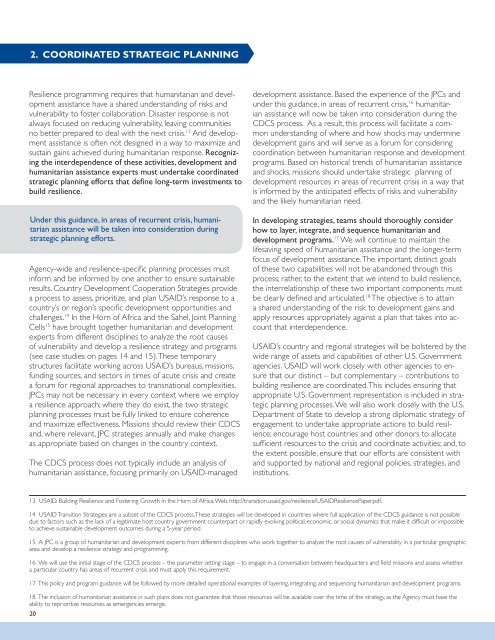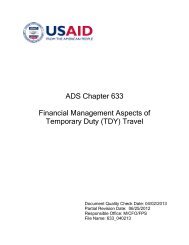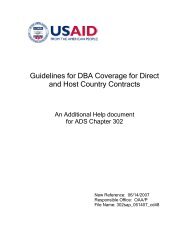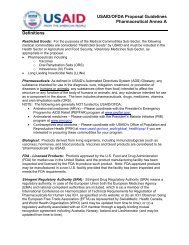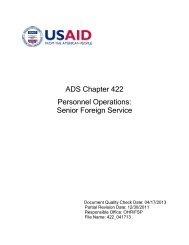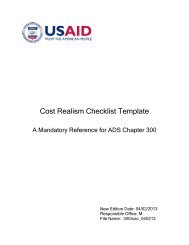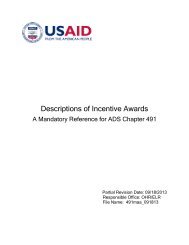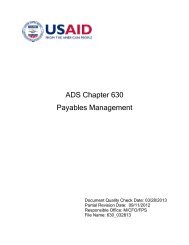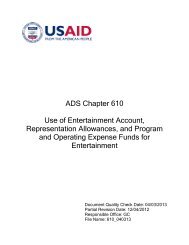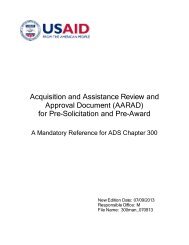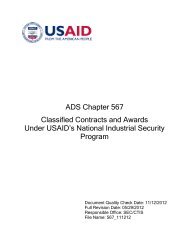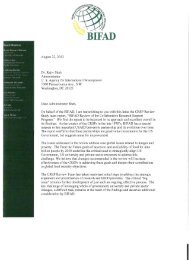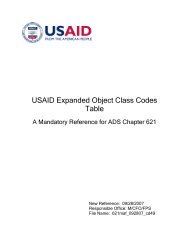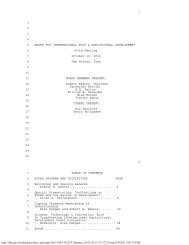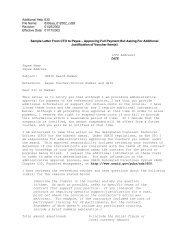USAID Policy Document - Resiliency FINAL 11-26-12.indd
USAID Policy Document - Resiliency FINAL 11-26-12.indd
USAID Policy Document - Resiliency FINAL 11-26-12.indd
- No tags were found...
Create successful ePaper yourself
Turn your PDF publications into a flip-book with our unique Google optimized e-Paper software.
2. COORDINATED STRATEGIC PLANNINGResilience programming requires that humanitarian and developmentassistance have a shared understanding of risks andvulnerability to foster collaboration. Disaster response is notalways focused on reducing vulnerability, leaving communitiesno better prepared to deal with the next crisis. 13 And developmentassistance is often not designed in a way to maximize andsustain gains achieved during humanitarian response. Recognizingthe interdependence of these activities, development andhumanitarian assistance experts must undertake coordinatedstrategic planning efforts that defi ne long-term investments tobuild resilience.Under this guidance, in areas of recurrent crisis, humanitarianassistance will be taken into consideration duringstrategic planning efforts.Agency-wide and resilience-specifi c planning processes mustinform and be informed by one another to ensure sustainableresults. Country Development Cooperation Strategies providea process to assess, prioritize, and plan <strong>USAID</strong>’s response to acountry’s or region’s specifi c development opportunities andchallenges. 14 In the Horn of Africa and the Sahel, Joint PlanningCells 15 have brought together humanitarian and developmentexperts from different disciplines to analyze the root causesof vulnerability and develop a resilience strategy and programs(see case studies on pages 14 and 15). These temporarystructures facilitate working across <strong>USAID</strong>’s bureaus, missions,funding sources, and sectors in times of acute crisis and createa forum for regional approaches to transnational complexities.JPCs may not be necessary in every context where we employa resilience approach; where they do exist, the two strategicplanning processes must be fully linked to ensure coherenceand maximize effectiveness. Missions should review their CDCSand, where relevant, JPC strategies annually and make changesas appropriate based on changes in the country context.The CDCS process does not typically include an analysis ofhumanitarian assistance, focusing primarily on <strong>USAID</strong>-manageddevelopment assistance. Based the experience of the JPCs andunder this guidance, in areas of recurrent crisis, 16 humanitarianassistance will now be taken into consideration during theCDCS process. As a result, this process will facilitate a commonunderstanding of where and how shocks may underminedevelopment gains and will serve as a forum for consideringcoordination between humanitarian response and developmentprograms. Based on historical trends of humanitarian assistanceand shocks, missions should undertake strategic planning ofdevelopment resources in areas of recurrent crisis in a way thatis informed by the anticipated effects of risks and vulnerabilityand the likely humanitarian need.In developing strategies, teams should thoroughly considerhow to layer, integrate, and sequence humanitarian anddevelopment programs. 17 We will continue to maintain thelifesaving speed of humanitarian assistance and the longer-termfocus of development assistance. The important, distinct goalsof these two capabilities will not be abandoned through thisprocess; rather, to the extent that we intend to build resilience,the interrelationship of these two important components mustbe clearly defi ned and articulated. 18 The objective is to attaina shared understanding of the risk to development gains andapply resources appropriately against a plan that takes into accountthat interdependence.<strong>USAID</strong>’s country and regional strategies will be bolstered by thewide range of assets and capabilities of other U.S. Governmentagencies. <strong>USAID</strong> will work closely with other agencies to ensurethat our distinct – but complementary – contributions tobuilding resilience are coordinated. This includes ensuring thatappropriate U.S. Government representation is included in strategicplanning processes. We will also work closely with the U.S.Department of State to develop a strong diplomatic strategy ofengagement to undertake appropriate actions to build resilience;encourage host countries and other donors to allocatesuffi cient resources to the crisis and coordinate activities; and, tothe extent possible, ensure that our efforts are consistent withand supported by national and regional policies, strategies, andinstitutions.13 <strong>USAID</strong>. Building Resilience and Fostering Growth in the Horn of Africa, Web. http://transition.usaid.gov/resilience/<strong>USAID</strong>ResiliencePaper.pdf.14 <strong>USAID</strong> Transition Strategies are a subset of the CDCS process. These strategies will be developed in countries where full application of the CDCS guidance is not possibledue to factors such as the lack of a legitimate host country government counterpart or rapidly evolving political, economic, or social dynamics that make it diffi cult or impossibleto achieve sustainable development outcomes during a 5-year period.15 A JPC is a group of humanitarian and development experts from different disciplines who work together to analyze the root causes of vulnerability in a particular geographicarea and develop a resilience strategy and programming.16 We will use the initial stage of the CDCS process – the parameter setting stage – to engage in a conversation between headquarters and fi eld missions and assess whethera particular country has areas of recurrent crisis and must apply this requirement.17 This policy and program guidance will be followed by more detailed operational examples of layering, integrating, and sequencing humanitarian and development programs.18 The inclusion of humanitarian assistance in such plans does not guarantee that those resources will be available over the time of the strategy, as the Agency must have theability to reprioritize resources as emergencies emerge.20


